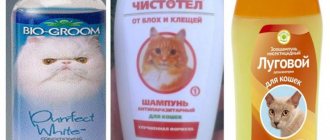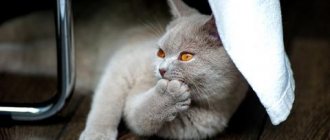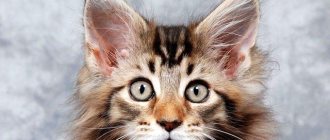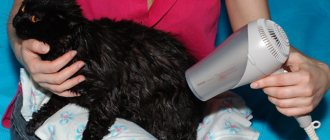There are many special products for bathing pets, but sometimes owners are interested in the question of whether it is possible to wash a cat with regular shampoo.
If there is an urgent need to bathe a cat, you can use a product intended for humans once. But it is better to use a special shampoo to wash animals.
Experts do not recommend using other means, because they can negatively affect the cat’s body:
- irritate the skin;
- disrupt the acid-base balance;
- deteriorate the properties of wool;
- provoke the occurrence of dandruff.
Shampoo for humans has a strong odor and additives that have a negative effect on the animal, as a result of which the cat develops severe itching, urination becomes more frequent, and behavior changes: the pet becomes restless and irritable.
What is the difference between pet shampoos and regular shampoos?
Special cleaning products are produced for cats.
Unlike human ones. they have characteristic features and a different composition:
- acidity suitable for cat fur;
- they do not contain aromatic components;
- minimum dyes;
- are developed taking into account the characteristics of the pet’s skin;
- do not have a sharp or unpleasant odor.
Shampoos for pets are:
- caregivers;
- cosmetic;
- medicinal.
Therapeutic detergents help rid the animal of fleas and other parasites that live in the fur and on the skin; they are produced to eliminate dandruff, allergic reactions, fungus, and lichen.
The care product is moderately alkaline. It provides silkiness and shine to your pet's coat .
Cat shampoos can be dry, they eliminate excess secretion of the sebaceous glands. They are applied to the pet's fur without rinsing off. You can purchase the product in spray form.
What to do if there is no suitable shampoo
If there is an urgent need to bathe your pet and you don’t have a cat wash product at hand, then preference should be given to the following “human” shampoos:
- For children without fragrances (for example, with the smells of apples or peaches) - they contain the least harmful substances and contain components that allow bathing “without tears.” Some breeders even specifically wash kittens with it if they have allergies.
- Contains birch tar. They are relevant for lichen or skin irritations in your pet.
- Based on goat's milk or kumis without additional fragrances, it moisturizes the hair and skin of cats well.
In any case, in these exceptional cases, you must choose a product without a strong odor, with a low composition of surfactants, and exclude the content of menthol or pepper.
When using such detergent compositions, it is better to dilute them strongly beforehand (up to one tablespoon per liter of liquid), and after soaping the animal, rinse the foam thoroughly (at least three to four times) until the water becomes clear. Then the pet is dried with a towel to reduce the licking time.
Features of washing cats with human shampoo
You can bathe an animal with human shampoo, but only in exceptional cases.
In this case, the following rules must be observed:
- It is not advisable to carry out water treatments for cats more than twice a year.
- The product must be diluted. To do this, add 1 tbsp to 2 liters of warm water. shampoo and stir thoroughly.
- Before soaping, the cat's fur should be moistened with a sponge.
- The product is applied so that foam forms.
- It is best to rinse the wool three times.
The following are considered contraindications for use:
- cat pregnancy and lactation;
- advanced age of the animal;
- period after surgery or illness;
- air temperature less than +22⁰С.
Why are veterinarians against it?
Doctors say that the pH of cat and human skin is different, so it is not advisable to wash your pet with human shampoo. This will ultimately lead to a deterioration in the appearance of the coat, which will lose its shine and smoothness. The skin will become irritated and dandruff.
Another reason is the strong fragrances in human shampoos. A cat's sense of smell is very sensitive, and a strong odor is not only unpleasant, but also dangerous for the cat. After such a procedure, some animals begin to mark their territory in order to ward off the intrusive aroma.
Why it is not advisable to wash cats with regular shampoo
It is not advisable to bathe cats using human shampoo. Veterinarians explain this by the fact that the structure of the skin of humans and cats is different. Humans have a much lower pH than pets.
The animal's skin has a protective layer. With frequent washing or exposure to detergent, it becomes damaged and takes a long time to recover.
During this period, the pet’s skin is very vulnerable, so the cat can quickly become hypothermic, become infected, or get a cold.
This is especially dangerous for kittens. If there is no special product, you should wash the cat with water without using shampoo or soap.
Features of cat fur
Cat fur has a number of specific features and is the thickest among all types of domestic animal coats.
The number of hair follicles per square millimeter of a cat's skin exceeds 200-300 units. For comparison, the most famous Merino sheep has this number of 165. Although now there are many unique breeds with original and even bare wool, for example, various Sphynxes.
Merino sheep
Hairless cats have to be bathed even more often than wool cats, since the hair of the latter has the properties of a kind of protection from external influences and is able to clean itself to some extent.
A cat's hair consists of the following structures:
- Cordiform layer. This is the main, central part of the hair. It is a cluster of keratinized cells, between which there are air cells. If the hair is mature, then in place of the core a cavity is formed in the upper part and at the base, enclosed in a protective cocoon.
- Cortical coating. This is the middle layer. It consists of axial hairs and spindle-shaped cells. They are tightly welded together and reliably cover the core, thereby ensuring the rigidity and elasticity of the cat's coat. This is where the pigment responsible for the color of the animal is located.
- Cuticle or scaly protection. It covers the cortex and consists of elongated flat keratinized cells that do not have a pigment composition. Their function is only to prevent the penetration of harmful substances, moisture, and pathogenic bacteria. In addition, the healthy shine of a cat’s fur depends on the quality of the scales, their microscopicity and tightness of fit to each other.
On all layers, cat hair contains sufficient keratin to ensure water resistance to the cat's coat.
Another feature of the hair is that all its cells are already dead and keratinized. Only the follicle is alive. It is the hair follicle that needs regeneration. The cat is special; its complex structure has been formed over the years of long evolution.
The strength of the hair root and the healthy shine of its wool part depend on the quality of the follicle. Next to the follicles are sebaceous glands and fan-shaped muscles. The former are responsible for lubricating the hairs, and the latter raise the hairs when necessary. Two hairs grow from each hair follicle - one guard (covering) and the second downy. The guard hair is long and straight, ending at the end with a kind of cone. Based on thickness, it is divided into four classes. The thickest and longest is located rarely, it is a guide.
The length and thickness of the guard hair determines the type of cat's coat. Their strength and straightness eliminate waviness. The thinner and weaker the integumentary hairs, the curlier the cat.
Downy hair is much shorter and thinner, wavy-shaped. It either does not have a middle layer, or it is very poorly developed.
Thus, a cat's hair grows in microscopic tufts, forming complex groups consisting of one guide, two or three regular guard hairs and from six to fifteen down hairs.
The hair follicles are located in the epidermis layer not perpendicularly, but at an acute angle, so the guard hairs always cover the down hairs, protecting them. That is why the lower the ambient temperature in the breed’s habitat, the thicker the undercoat (more fluff) of its representatives.
Over the years, many varieties of cats have mutated, and man has also created new selections and breeds that differ, among other things, in the type of coat: short (regular and Siamese-oriental group), long, semi-long and its complete absence (hairless or hairless pets).
In order to effectively care for a cat, it is necessary to select the shampoo that is intended for a specific type of coat. Although bathing a cat is not an urgent need. Nature itself has taken care of protecting the animal’s skin due to the air layer and natural lubrication, and the pet can carry out hygienic cleaning on its own with its long and hard tongue.
What shampoo can be used for cats
If you need to wash your cat with regular shampoo, you should choose the right one.
The product must meet the following criteria:
- it should not smell strong and pungent;
- with a high pH content;
- It is advisable to take baby bathing product.
For washing, take a 2 in 1 liquid (with the addition of conditioner or balm).
Experts recommend diluting this shampoo with water in the following proportion: 1 tbsp. for 1 liter of water.
Using shampoo for children
You can bathe your cat with baby shampoo because it is mild, does not have a strong odor, and is hypoallergenic.
Is it possible to wash a kitten with laundry soap?
The most natural soap is considered to be laundry soap. It is valued for its good cleaning ability. But it is wrong to believe that it is suitable for bathing kittens.
Common people believe that they can wash cats with laundry soap. It’s better not to do this, but to choose a less aggressive one, with a low alkali content or a neutral PH level.
If there is no special shampoo and the kitten needs to be washed, a solution of laundry soap will do. It is suitable as an emergency measure. The cat may develop dandruff and itchy skin after a bath. Some cats experience hair loss, and allergic reactions are possible.
Laundry soap 72% from the era of socialism for a pet is a kind of poison. It is important to rinse the wool well so that the pet is not poisoned by soap components.
If you find problems after washing with laundry soap, you should immediately contact a veterinarian. He will tell you how to minimize the effects of alkaline attack on the skin.
How to properly wash your pet
Recommendations for using human shampoo to wash your cat:
- If the cat has long hair, then the animal should be thoroughly combed before starting the procedure.
- For the comfort of the animal, you need to put a soft cloth on the bottom of the bathtub or basin - this prevents slipping along the bottom.
- The optimal water temperature is slightly higher than the pet’s body temperature (+37.5…+39⁰С).
- Wash the animal with a soft sponge, making sure that the product and water do not get into the cat’s ears.
- The product is washed off from the wool using a spray bottle.
- The duration of the procedure is about fifteen minutes.
- After bathing, the cat is wrapped in a towel until the fur is dry.
The rules for bathing animals with shampoo for humans are as follows:
- You should not wash your cat often (bathe no more than once a quarter).
- After vaccination, cats cannot be bathed for three days.
- Water procedures are not recommended immediately after eating. The interval between feeding and bathing should be at least two hours.
- If your cat is stressed after bathing, you can give sedatives before bathing.
- To prevent water from getting into your ears, and also to prevent otitis media, you can use cotton wool pads or a cellophane cap.
Bathing is often stressful for animals, so to prevent your pet from scratching you, it is advisable to trim its nails before the procedure.
How to wash if the cat is afraid
A cat's fur protects it well from overheating and excessive cooling, and when wet, the air cushion between the hairs and skin fills with water, and the animal begins to freeze very much. This is why most pets do not like bathing and strive to avoid this procedure with all their might.
Read the article why cats are afraid of water and what to do about it.
In addition, the aroma of detergents is also unpleasant for cats; their delicate sense of smell is simply shocked by these odors. However, specialized cat shampoos take this criterion into account and do not contain fragrances.
If a cat is not accustomed to bathing from an early age, and is also afraid of water, then this procedure can become serious stress for both the pet and the owner.
In order to irritate your cat as little as possible, you should adhere to the following rules:
- It is advisable to invite someone from your household to help.
- Pre-comb the cat's fur and trim its claws.
- Under no circumstances should you shout at your pet; you should only speak in a gentle and soothing tone.
- It is better to place an anti-slip mat at the bottom of the bathing container.
- Remove from the surrounding area everything that could interfere, fall, or additionally frighten the cat, for example, bottles of shampoos and conditioners standing on the edge of the bathtub.
- Prepare several large dry towels.
- Prepare water for rinsing in a separate container; it is better to do it using a jug rather than a shower, so that the extra noise does not further frighten the cat.
- Fill a basin or bathtub with water at the animal’s body temperature so that its surface is slightly higher than the level of the cat’s belly.
- It is worth starting the procedure when the pet is relaxed and calm.
- Going into the bathroom with him, hold him in your arms for a while, talking affectionately.
- Then carefully place in water.
- While your assistant is holding the cat, quickly lather the fur with cat shampoo.
- Then thoroughly but quickly rinse your pet from the ladle at least three times.
- Place the cat on the bathroom floor and rub him well with a towel.
- Then wrap it in a second dry cloth and leave the bathroom.
- Carry the cat in your arms, calming and talking to him affectionately.
- Do not use a hairdryer under any circumstances, this will only frighten your pet even more and discourage him from bathing forever.
- Once the animal is dry enough, lower it to the floor and let it lick itself.
- Play, talk affectionately, offer the cat a treat, praise.
Will a “bath day” harm your pet?
There is no clear answer. On the one hand, a healthy cat is truly capable of caring for its fur on its own no worse than a professional groomer. In addition, most breeds have a thin layer of protective fat, and its frequent destruction can damage the hair coat.
On the other hand, most modern cats do not live in environmentally friendly conditions, and even if the pet does not go outside, you yourself will add almost the entire periodic table of purrs to your “diet” on your clothes and shoes. So the most sensible thing is to bathe, maintaining a balance of cleanliness and natural needs.
Health issues
A natural love or habit of water procedures is rare among cats. Therefore, every bath is stressful for the animal. You can wash a cat when you are sure that the animal is healthy, has no fever, lethargy, excellent appetite and habitual behavior.
You should not combine bathing procedures with preventive treatment against worms and vaccinations, as they temporarily weaken the animal’s immunity. But bathing, especially with the appropriate shampoo, will greatly help with the prevention or extermination of fleas.
In the normal course of pregnancy, bathing should not harm the mother, but, firstly, it is still stressful, and secondly, a minimal amount of detergent will remain on the fur and enter the body. Therefore, bathing pregnant cats is not recommended. It is better to use dry cleaning of wool.
If you decide to castrate your cat, then you should bathe him before the operation, since during the postoperative period you cannot wash the suture - only treat it with antiseptics. On average, swimming is prohibited for about two months after castration, but it all depends on the speed of wound healing.
A kitten from a breeder is bathed for the first time after two to three weeks in a new apartment, so that the baby gets used to it and recovers from the move. But it is better to postpone acquaintance with the bathroom until four to five months, until the first “teenage” molt begins and the teeth change.
The bathing schedule is individual, depending on the breed and habits of the pet, climate, living conditions and other factors. On average, free-range cats are recommended to be washed once every two to three months. “Homebodies” two to three times a year, preferably during seasonal shedding, to remove lost hair and undercoat.
If heavy dirt or chemicals get on the fur, it is necessary to bathe the cat outside the schedule and as quickly as possible, before the animal licks off the dirt and gets poisoned.
Pedigree cats and cats participating in exhibitions are washed more often, according to the schedule of performances and events.
Among the breeds that are most often washed, hairless cats are Sphynxes, Bambinos, and Lykoeis, since their sebum tends to accumulate and smell bad. Breeds prone to water procedures: Maine Coons, Abyssinians, Siberians, Bengals also “bathe” more often than others. If your cat loves water and climbs into the bathroom on his own, you can allow him to “shower” periodically, but do not use special products every time.
During the molting period, Siamese and Oriental cats, English (Cornish) and Ural Rex cats are not bathed. They shed so much that after swimming, bald spots may remain on their fur coat.
Useful video
Visually learn how to wash a cat with tar soap!
Laundry soap was one of the main hygiene products for Soviet citizens. So they used it for washing, washing, and bathing pets. Modern cat owners have access to pet shampoos, but they continue to believe in the amazing properties of laundry soap.
Aggressive components
Lye is included in this detergent. The substance in high concentrations causes burns, and in moderate concentrations it dries out the skin and causes crusts and dandruff to appear.
What are the dangers for a cat when bathing with laundry soap? Allergies, rashes and itching. The pet's fur becomes faded and slick. The hairs become tangled and can only be removed with scissors.
We must not forget that cats constantly lick themselves, and if the remaining soap is not washed off well, the alkali will end up in the animal’s stomach. Several such baths, and poisoning is guaranteed.
Laundry soap does not protect against fleas. You can use it to wash your cat's paws if your pet decides to walk through the mud, or a greasy tail, but carefully wash off any remaining product.
What to bathe with?
There are many cat shampoos sold in pet stores. They clean the fur and get rid of parasites. For one-time use, children's or "adult" shampoo is suitable, but such a cosmetic product cannot be used regularly.
How to wash a cat?
To wash cats you need a special shampoo. Since the pH of humans and cats is different, ordinary human soap or shampoo has an adverse effect on the pet's skin and coat - it may lose shine, become tougher, or develop irritation on the skin. They may also contain various fragrances that the sensitive cat’s nose does not like. In addition, a specialized shampoo contains additives, for example, that allow you to quickly remove fleas.
Shampoo can be of 3 types:
- Dry – has the form of powder, which is applied to the animal’s fur and combed out after some time. It is suitable for long-haired cats that take a long time to dry and those that absolutely cannot tolerate bathing. The downside of this shampoo is its weak cleaning properties.
- Sprays are more advanced than dry ones and also do not require rinsing.
- Liquid is the usual form of shampoo (the same as in humans). They clean the cat's coat best, but this kind of washing is the most unpleasant for the cat.
Long live the fluffy towel
The final touch is drying. We have already found out how to wash cats, and now we will find out how to properly dry the fur so that your pet does not catch a cold.
Immediately after bathing, wrap the wet animal in a soft towel. Pull her close and hold her in your arms for a little while. Your body heat will calm your cat.
Experts do not recommend using a hair dryer when drying. The only exception, perhaps, is participation in a cat exhibition. Then the fluffy beauty should appear before the audience in all its glory.
But at home, you shouldn’t once again scare your cat with a buzzing monster. Lay a bedding near the radiator and place your pet on it. The moisture from the wool will evaporate on its own at an air temperature of 24-25 C°. It is important that there are no drafts in the room during drying, so close all doors and windows tightly. And leave the cat to finish her toilet in peace.
Cats trust their owner unconditionally. Therefore, it is in your power to carry out bathing with maximum comfort, both for the animal and for the whole family. Over time, you will determine how often you need to wash your cat individually, watching your furry beauty.
How and when to wash a kitten for the first time and with what?
Tar soap based on birch tar contains natural substances that have disinfestant properties. It is believed that it can remove fleas from cats.
We invite you to read: Gentamicin instructions for use for animals, gentamicin for cats
Tar soap is used against fleas on cats.
If you still decide to remove fleas from a cat with tar soap, it is done like this:
- Prepare a soap solution. 0.25 soap is grated and completely dissolved in 200 ml of warm water.
- Moisten the cat's fur with regular warm water.
- Treat the wool with a solution of tar soap so that it gets on the skin. Thoroughly wash the folds of the paws, under the tail, neck and withers.
- Keep the animal in a soap solution for 5-10 minutes.
- Carefully wash off the tar soap from the cat's fur.
- Repeat the procedure every 2 weeks as necessary (it is in 2 weeks that flea eggs hatch).
How and when to wash a kitten for the first time and with what?
For regular care of animals, special products are needed.
They are less aggressive in composition than regular shampoos. It is best to wash the cat with warm water and beaten egg yolk. If that doesn’t work, you need compounds with PVA. Let's discuss what to choose from what is in the bathroom.
Regular soap
It is not recommended to bathe a kitten with soap with a strong fruity or floral aroma. Bath, pine, and baby soap are preferable. Experienced veterinarians do not advise excessive soaping of the animal.
You shouldn't bathe your pet too hard. He must have natural protection.
Baby shampoo
Products used to wash children under three years of age are hypoallergenic. They contain less of all kinds of synthetic additives and more natural ingredients. But you can’t get carried away with them either.
The product is pre-diluted 1:3 and foamed well. And then the kitten is treated with foam. You need to carefully clean the face.
Phrases like “washes without tears” are a marketing ploy. When foam gets into the eyes of animals, conjunctivitis develops. The small pet will become restless. Ears are a no-go area. They are cleaned with ear sticks with water, lotion or saline solution.
Some owners use human shampoo to care for their pets, and do this regularly. Veterinarians strictly prohibit doing this. The secretion of fatty glands is disrupted, the skin suffers, and the structure of the hairs changes.
Allergic dermatitis and other skin diseases are possible. Immunity weakens. After washing, cats get sick more often and can get pneumonia.
The soap composition is made by diluting the shampoo with water, increasing the volume at least five times. In this case, it will be possible to protect the cat from the consequences and reduce the risk of developing skin diseases.
Tar is an excellent folk remedy for skin irritation. Liquid soap or tar shampoo is a good insecticidal remedy for blood-sucking insects.
If your pet constantly scratches itself with its paws or bites something out of its fur, it may have fleas. Try washing it with tar soap. This primitive method is used in folk medicine.
The most natural soap is considered to be laundry soap. It is valued for its good cleaning ability. But it is wrong to believe that it is suitable for bathing kittens.
Common people believe that they can wash cats with laundry soap. It’s better not to do this, but to choose a less aggressive one, with a low alkali content or a neutral PH level.
If there is no special shampoo and the kitten needs to be washed, a solution of laundry soap will do. It is suitable as an emergency measure. The cat may develop dandruff and itchy skin after a bath. Some cats experience hair loss, and allergic reactions are possible.
If you find problems after washing with laundry soap, you should immediately contact a veterinarian. He will tell you how to minimize the effects of alkaline attack on the skin.
Veterinarians generally do not recommend washing animals frequently.
- The procedures are recommended for adult cats during spring molting so that less fluff accumulates in the stomach and does not cause constipation.
- Cats can only be washed with regular shampoo when nothing else is available. But you need to choose dermatological compositions based on soap root, without lauryl sulfates, dyes, fragrances, and with a small amount of PVA.
- Tar product is used as a flea prevention for kittens from 8-10 weeks of age. After the procedure, the animal cannot be fed for four hours; water must be given. Treatment is carried out no more than once a month. Apply the soapy liquid for 3-5 minutes, then rinse with cool water.
- Do not wash cats with hot water; the functioning of the sebaceous glands is disrupted. It is important to avoid foam getting into your ears, eyes, and mouth.
- Hypoallergenic baby washes can be used for cats if special shampoos are not available. They are not so concentrated. They must be diluted with water. Children's liquid cream soap is safer and better in composition.
- It is important that there are no wounds or scratches on the kitten’s skin. If possible, it is better not to wash a dirty pet; just wipe it with a soft, damp cloth to remove heavy dirt. After such a procedure, he will not get sick, he will get better on his own within a couple of days.
By properly caring for their pet, owners save themselves from unnecessary hassle and trips to the veterinarian. A fluffy meowing pet is not a toy, but a living creature that does not need to be constantly washed with shampoos, they are harmful to it. It is important to protect kittens from water procedures after vaccinations; they are especially vulnerable.
Unless there are any special circumstances, a mother cat successfully cares for her babies, including their fur. In the first month from birth, healthy kittens do not need bathing.
We invite you to familiarize yourself with: Breeds of dairy cows Ayrshire dairy breed
You need to wash your kitten for the first time at the age of 3-4 months.
It is not recommended to bathe younger kittens because:
- baby may get scared
- if he's with his mom, she might not recognize him as smelling like shampoo
- The baby has not yet established thermoregulation, he may freeze and get sick
So, the decision was made to wash the kitten. What's the best way to do this?
- The procedure should be carried out 2 hours after feeding the kitten.
- It is necessary to prepare the bathing area so that cat shampoo and two terry towels are at hand. How to choose a shampoo can be read below.
- It is better to bathe a kitten not in the bathtub, but in the sink and basin. Lay a terry towel or cotton sheet on the bottom.
- Approximately 5 cm of water is collected in a sink or basin. Her temperature is measured. 38 degrees is the optimal indicator.
- It is better to turn off the tap while bathing the kitten; the noise of the water may frighten it. You can wash off the shampoo with a ladle or a mug. If the wool is dense, it can only be washed with running water; the stream from the tap or shower should not be under high pressure.
- The kitten should not be immersed in water abruptly, starting with its hind legs. At the same time, it is important to stroke him and calm him down.
- Perhaps, like a child, a kitten will tolerate bathing more easily if it has balls and toys - squeakers - that will distract it from the unpleasant procedure.
- You need to water the kitten's body very carefully, making sure that water does not get into the eyes and ears. The shampoo should be rinsed off the fur thoroughly.
- After bathing, the baby should be wrapped in a towel to prevent him from freezing. When the towel gets wet, it should be replaced.
- Dry the kitten's fur with a soft brush or hairdryer if he is not afraid of it.
To calm your kitten while bathing, you need to talk to him.
Your pet's favorite toy will also help. Veterinarians strongly do not recommend bathing cats with ordinary human shampoo. The pH of an animal is different from that of a human; on average, it is higher. Human cosmetics can cause skin diseases in a cat or damage its fur.
Fortunately, pet stores and veterinary pharmacies have a variety of cat bath products.
What are they? According to the form of release, shampoos for cats are:
- dry
- liquid
- in the form of sprays
We suggest you read: Why cats and cats trample a person and a blanket with their front paws and purr
Dry shampoo is a real salvation for cat owners who do not like to bathe. The product has the form of powder, which is applied to the animal’s fur coat and after a while is removed from it with a comb. It is also suitable for long-haired cats, which take a long time to dry after regular bathing and risk catching a cold. The disadvantages of dry shampoo are that it cannot cope with heavy dirt and is not very suitable for cats with dark hair.
Shampoo-powder for cats.
The choice of spray shampoos is not yet very wide; they work on the same principle as dry ones. In addition, sprays protect the animal's fur from static electricity.
Shampoo in spray for cats.
Liquid shampoos are still the most popular. They clean the cat's fur well from dirt, make it easier to comb, and help cope with many problems. Liquid cat shampoos are:
- for cats of different breeds with different hair lengths or hairless
- for cats with oily or dry skin
- tint, emphasizing or slightly changing the natural color of the animal
- anti-parasitic against fleas
- from tangles and to make combing easier
- antifungal
- preventive, for regular hair and skin care
Liquid shampoos for cats.
Of course, when you get a cat, it is better to immediately buy shampoo for him. But if it happens that your pet gets dirty, and there is no special product to wash it, you can use regular human shampoo once, preferably baby shampoo:
- fragrance-free
- no dyes
- hypoallergenic
It is better not to use shampoo with conditioner.
You can also make a weak solution of laundry soap and rinse it off the wool very thoroughly.
Is it possible to bathe a cat in the heat?
If a cat suffers from the heat in the apartment in the summer, the owners may want to give it a bath to refresh it. But frequent bathing, as is already known, can be harmful. Therefore, “refreshing procedures” are recommended to be carried out as follows:
- place a wet towel within reach of the animal so that it can lie on it or wet its paws
- spray the cat with water from a spray bottle
- wipe the cat's head and paws with a damp cloth
And even in these cases, the water should not be very cold so that the cat does not catch a cold.










